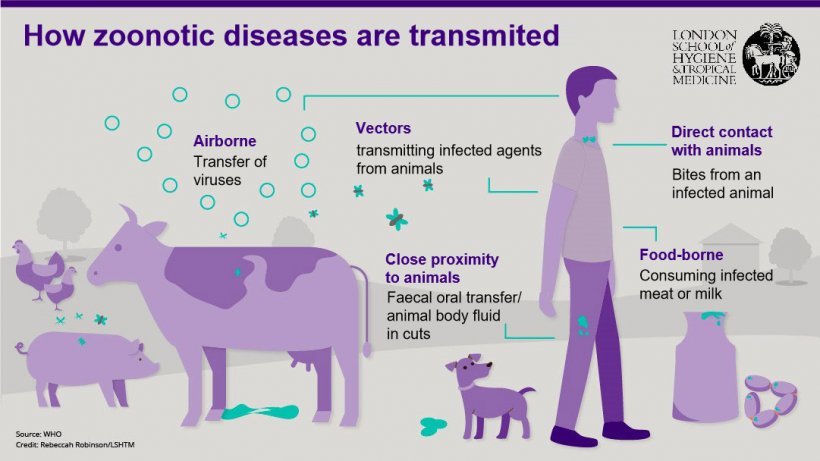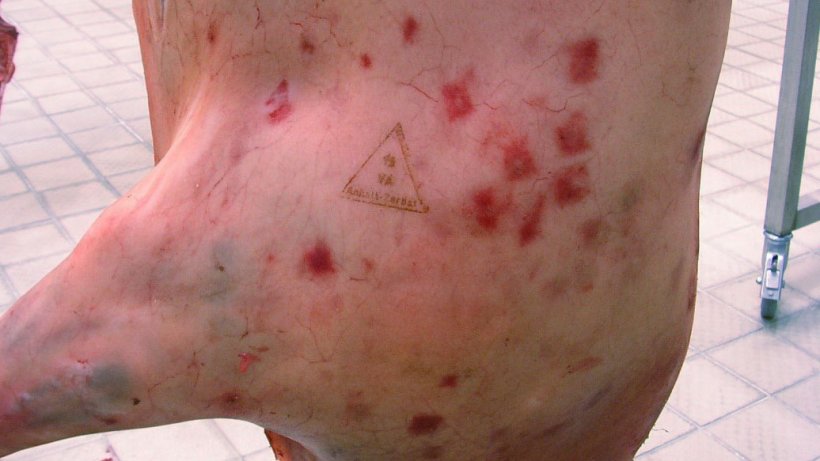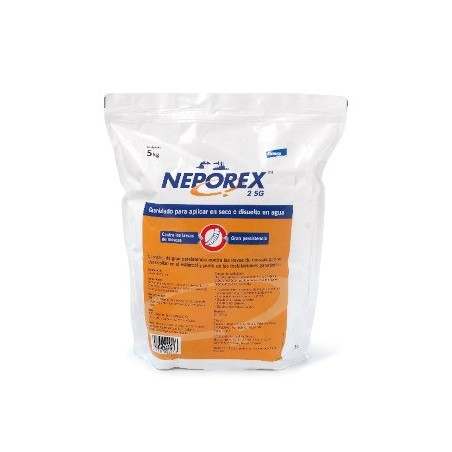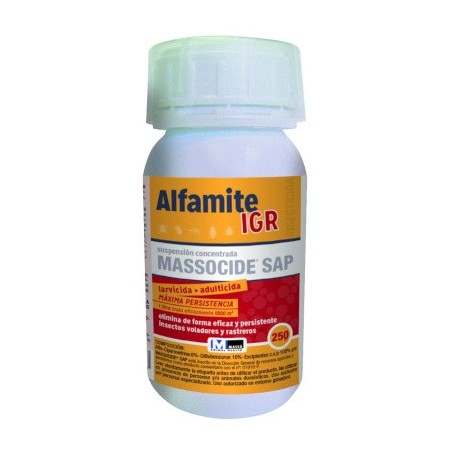An occupational disease is any illness that occurs as a result of someone’s profession due to which a person may be more exposed to certain diseases than the general population. An occupational diseases was silicosis of the miners due to their long-term exposure to dust in the mines or noise-induced hearing loss of people who worked with loud machinery but without ear protective gear.
In pig supply chains, people working at every node, may be exposed to occupational disease risks due to their work with pigs, too. A pig farmer, veterinarian or live animal transporter may be bitten by an animal, but other than the physical danger, pigs can carry diseases that are potentially infectious to humans and can be transmitted through close contact or handling of infected animals (Figure 1). The level of exposure on farm or during transport depends largely on the production type, e.g. commercial farmers with herds of hundreds or thousands of animals do not usually have close contact with their animals and if they do, they are wearing mostly protective gear,. In low-income countries where pigs are reared mostly by smallholders in extensive production systems, with contact to the environment , infection with diseases originating from pigs are much more common and include a wide spectrum including gastrointestinal worms, brucellosis or infections with zoonotic swine influenza viruses (Table 1).


Table 1: Selected pig zoonoses with emphasis on low-and-middle income countries.
| Predominantly foodborne pig zoonoses | Predominantly occupational pig zoonoses |
|
Transmitted via ingestion of the pathogen inside the meat (i.e. Trichinella spp.) or on the surface of the meat (i.e. Cryptosporidium spp. through contaminated water used for processing meat). |
Transmitted via air (i.e. Coxiella burnetii), skin (i.e. Brucella suis) or vectors (Trypanosoma spp.), especially to people more frequently exposed to these transmission routes due to their occupation. Bacillus anthracis |
*The authors make no claims for completeness of this list
However, most infections with occupational diseases occur at slaughter, when humans handle potentially infected meat or body fluids, and we will introduce two major ones here.
1. Swine erysipelas in humans
Swine erysipelas is caused by a bacterium called Erysipelothrix rhusiopathiae; it is carried by many mammals, fish and birds worldwide, but pigs are the most important reservoir. It can also survive in the soil for up to one month. Pigs can get infected when ingesting it with contaminated soil or water, and humans may get infected when the bacterium enters the human skin through small scratches or wounds. This is most likely to happen during slaughter and further processing of pigs when butchers handle sharp objects (e.g. knives and hooks) and infected meat, pigs’ nasal discharge, urine or faeces without proper protective gear (e.g. chain mesh gloves). In pigs, the disease can cause different lesions being the most characteristic in the acute state of the disease rhomboid-shaped lesions in the skin. Therefore, the disease is often referred to as diamond skin disease (Figure 2).

In humans, infection may limit itself within a week or two. However, it may also result in a painful skin infection (called the erysipeloid), often on the hands, which can fairly easily be treated with a course of antibiotics. If left untreated, it may cause fever, joint pain, septicaemia and, in the worst case, death due to infection of the heart. Swine erysipelas is not a common problem in Central Europe anymore because, vaccination against the disease-causing strains in sows and gilts is available and widely implemented in most farms, protective gear at slaughter is mandatory, and the human population is generally healthy and therefore not as susceptible. Erysipelas as an occupational disease in butchers and raw pork handlers seems to be emerging in low-and-middle income countries (Musewa et al. In press) where pig production systems with a high level of informality and potentially immunocompromised human populations at risk (e.g. poor nutrition or the presence of diseases compromising the immune system) exist. The bacterium can be easily destroyed during proper cooking but raw pork handlers including those cooking the meat should be aware.

2. Infection with Streptococcus suis
Healthy pigs normally carry the bacterium in their nose and mouth, in their digestive and urogenital tract. However, some strains (in particular serotype 2) cause a serious disease in pigs. Anyone handling the live pig (pig farmers, veterinarians, pig transporters, abattoir workers) or the raw pork (abattoir workers, meat inspectors, pork transporters and cooks) may be exposed. The bacterium enters human skin through almost invisible punctures or scratches and then may replicated in the blood (Hughes et al. 2009). In people this can lead to septicaemia and infection of the brain which, if left untreated, can result in permanent deafness. There seem to be different strains in different geographical areas, and strains in Asia are apparently more harmful to humans than strains in Western countries. However, also in industrialised countries, mortality occurs. A vaccine for neither pigs nor humans has been developed but antibiotic treatment can be administered if the disease in pigs and/or people has been diagnosed.
Conclusions
There are many more diseases that may come over humans through pork consumption, such diseases are called food- or pork-borne infections and only cause disease when ingested through consumption. These include but are not limited to infections with Campylobacter, Listeria, Salmonella, Yersinia or toxigenic Escherichia coli, certain Staphylococcus aureus and Mycobacterium avium intracellulare complex (MAIC). At some occasions, at home, consumers are cooks and should observe similar rules as professional chefs in restaurants: never use the same cutting equipment for raw and cooked food or meat and vegetables, protect your skin from cuts and scrapes, avoid touching your mouth and wash your hands with hot water and soap at the end of the food preparation.






